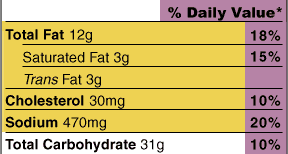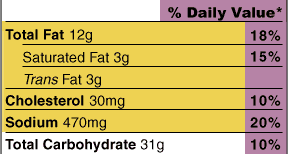The US FDA (Food & Drug Administration) has very strict and specific rules laid down about what must legally appear on food and beverage labels for consumable products sold in the United States. The traditional Nutrition Facts label is quite familiar to everybody:
Package Labels: Servings Per Package Rules
However, most people don’t really pay attention to a critical part of the label: The servings per package.
When you show per serving nutrition information on a food label, most people will look at the calorie and fat information and feel good about their purchase and consumption. It’s psychologically comforting to look at a number, say 223 calories, and think “This is what I’m eating. It’s not too bad.”.
However, when the package has a strange number like “2.5 servings per package”, not many people are actually going to sit there and do the math of 223×2.5 to see what a full package contains. Besides, most of the servings sizes that manufacturers list are much smaller than a normal person would eat. The problem is even worse in packages that appear to be single-serving and yet still show multiple servings per package.
It’s very important to check the serving size on food and beverage labels. Make sure you fully realize what you’re ingesting in terms of serving sizes and calories, fat, and sugar per serving.
How do you define servings per pack?
When calculating “servings per pack” for your labels, consider this to be the total number of portions in one pack based on typical use or consumption guidelines. Servings per pack are important as they tell the consumer how much of the product is a serving, against regulatory standards, and so they can make informed dietary or usage decisions. To calculate, take the total quantity (weight, volume or count) of the product and divide by the serving size you specify.
For example if you have a snack in a 300g bag and the serving size is 30g the servings per pack would be 10. Defining servings per pack on your labels helps consumers with portion control and nutritional tracking and builds trust as it tells them exactly what they are getting per purchase. We make sure this information is clear, compliant and product specific.

